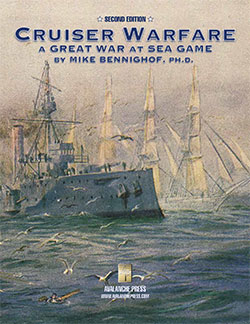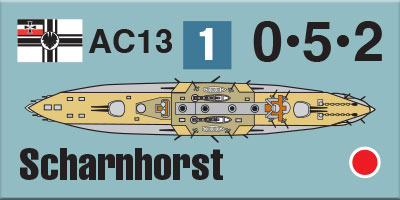Cruiser Warfare (Second Edition):
Design Notes
by Mike Bennighof, Ph.D.
June 2022
 Great War at Sea games built the original Avalanche Press, and now we’re re-launching the entire series with new series rules – the first time we’ve done this for our original series. It’s a momentous occasion for us, though that’s mostly inside baseball. What it means for the world of gaming, is that we’re bringing back the world’s best series of World War One naval games. Great War at Sea games built the original Avalanche Press, and now we’re re-launching the entire series with new series rules – the first time we’ve done this for our original series. It’s a momentous occasion for us, though that’s mostly inside baseball. What it means for the world of gaming, is that we’re bringing back the world’s best series of World War One naval games.
Great War at Sea: Cruiser Warfare is the outlier in the group. Where other Great War at Sea games are played on an operational map showing just the area of conflict (the North Sea, Mediterranean, Caribbean or Sea of Japan), Cruiser Warfare has a world-wide strategic map divided into areas – very large areas, since we’re looking at the entire globe.
At the outbreak of World War One in August 1914, the German Navy included a squadron of armored and light cruisers stationed at the German colony of Tsingtao in China. Cruiser Warfare is the story of the German East Asia Cruiser Squadron’s attempt to steam around the world from China back home to Germany, and the actions of other German cruisers against Allied commerce. While the German ships are well-crewed, they are coal-burners constantly seeking fuel supplies and they must cover an enormous distance to reach their goal (while inflicting punishment on the Allies along the way). The Allied player has overwhelming, mostly British force (particularly in the eastern Pacific, once the Japanese enter the fray), but the Central Powers (there’s also one ancient, useless Austrian cruiser) have an awful lot of ocean in which to hide (with a few exceptions, all of it, though it’s hard to find coal in the Bering Sea).
It's actually not likely that the Germans can make it back to Germany; they’re going to win the game by going out in a blaze of glory, inflicting as much damage on the Allies as possible and keeping valuable enemy fleet units tied down far away from European waters. It’s kind of difficult a century later to determine just what Maximilian von Spee had in mind when he set out across the Pacific; he appears to have given up the notion of returning to Germany but continued to tell his men that they were headed for home. The German player can still win without a triumphant return, and most German wins in game terms probably will come without such an event.

And, this being an Avalanche Press game, we have plenty of options, too. Cruiser Warfare’s Second Edition adds even more of these, like the pair of German dreadnoughts that visited Brazil just before the outbreak of war remaining there when the hostilities actually begin. Variable entry of the Allied powers, or a Central Powers-aligned Italy (adding one crapulent cruiser, but more coaling possibilities). Another German cruiser squadron, this one based in German East Africa. Stronger Allied presence in distant waters.
The game plays very differently than any other Great War at Sea game, with more emphasis on the “game” part than most. It’s the game with which I’d most recommend using the Basic Combat rules (the line-’em-up-and-shoot rules that no one ever uses) to speed play. With no plotting by the Allied player, and only a few fleets under Central Powers command, the game moves much faster than the usual Great War at Sea contest and you’ll have an easier time luring the unwary into playing it with you again and again. Fuel use, for example, is much simpler than in the standard rules. Since coal – its use and the quest to obtain more – is such a driving force in this game, much more so than in the others, the rules themselves need to be very straightforward.
While Cruiser Warfare has its own, unique rules for strategic movement (with a lot of emphasis on coal), the tactical portion (where the ships fight each other) is right out of the Second Edition standard series rules. With only a handful of dreadnought-type ships in the mix and most of those confined to the optional set-up variants, play on the tactical map tends to move very quickly.

The Second Edition carries over the map from the final edition, which is a very fine map. Everything else has been replaced, starting with the playing pieces. They are now our wonderful die-cut and silky-smooth pieces, cut with 22nd-Century technology using blades so sharp that little pressure is needed to press them through the chipboard. That means that these pieces lack the mark left by the force of 10,000 hammers used to die-cut traditional wargame pieces – there’s no trough on the flip side, and it’s so smooth that we make to mark it with a color stripe else you’ll not be able to tell front from back. They also feature incredible reproduction and rich colors; we’ve had to replace all of the artwork since every flaw would otherwise be visible.
All of that adds up to the finest wargame pieces in known space. And, compared the to earlier edition, there are more of them. That same technology allows us to easily change the layout of the die, and that let us add more pieces and switch some of the ships represented on square pieces in the old edition to the double-sized “long” pieces we use for major warships in Great War at Sea games.

Cruiser Warfare, like most of our games these days, is packaged in our Playbook format. It’s a complete game, or at least as complete as we can make it (you’ll need to provide your own dice). Like other Great War at Sea games, it has enormous re-play value, with variable starting situations (almost all of them revolving around Graf von Spee’s mad scheme) and a dozen battle scenarios involving only combat on the Naval Tactical Map.
Cruiser Warfare is a very different game than its near-sisters, and I’m glad we were able to bring it to the same rules and graphics standards as the other games. All of the Great War at Sea games are receiving new editions, built around the Second Edition series rules. After this many years, the games still hold up as good expressions of history that are fun to play, and I’m very proud of all of them.
Right now, Gold Club members can snare an upgrade set with the beautiful new pieces and the new rules/scenario set. If you already own the game, it’s worth having.
Click here to join the Gold Club.
See your Gold Club Insider newsletter for ordering information.
Sign up for our newsletter right here. Your info will never be sold or transferred; we'll just use it to update you on new games and new offers.
Mike Bennighof is president of Avalanche Press and holds a doctorate in history from Emory University. A Fulbright Scholar and NASA Journalist in Space finalist, he has published a great many books, games and articles on historical subjects; people are saying that some of them are actually good.
He lives in Birmingham, Alabama with his wife, three children and new puppy. He will never forget his Iron Dog, Leopold.
Want to keep Daily Content free of third-party ads? You can send us some love (and cash) through this link right here.
|
